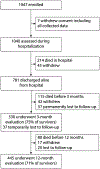Prevalence and Course of Frailty in Survivors of Critical Illness
- PMID: 32618688
- PMCID: PMC7941759
- DOI: 10.1097/CCM.0000000000004444
Prevalence and Course of Frailty in Survivors of Critical Illness
Abstract
Objectives: Little is known about frailty that develops following critical illness. We sought to describe the prevalence of newly acquired frailty, its clinical course, and the co-occurrence of frailty with disability and cognitive impairment in survivors of critical illness.
Design: Longitudinal prospective cohort study.
Setting: Medical and surgical ICUs at five U.S. centers.
Patients: Adult patients treated for respiratory failure and/or shock.
Measurements and main results: We measured frailty with the Clinical Frailty Scale at baseline (i.e., study enrollment) and at 3 and 12 months postdischarge. We constructed alluvial diagrams to describe the course of frailty and Venn diagrams to describe the overlap of frailty with disability in activities of daily living and cognitive impairment. We included 567 participants a median (interquartile range) of 61 years old (51-70 yr old) with a high severity of illness (Acute Physiology and Chronic Health Evaluation II of 23). Frailty (Clinical Frailty Scale scores ≥ 5) was present in 135 of 567 (24%) at baseline, 239 of 530 (45%) at 3 months, and 163 of 445 (37%) at 12 months. Of those with frailty at 3- or 12-month follow-up, 61% were not frail at baseline. Transition to a worse frailty state occurred in 242 of 530 of patients (46%) between baseline and 3 months and in 179 of 445 of patients (40%) between baseline and 12 months. There were 376 patients with frailty, disability, or cognitive impairment at 3-month follow-up. Of these, 53 (14%) had frailty alone. At 12 months, 276 patients had frailty, disability, or cognitive impairment, 37 (13%) of whom had frailty alone.
Conclusions: Frailty is common among survivors of critical illness. In the majority, frailty is newly acquired. Roughly one in seven had frailty without co-occurring disability or cognitive impairment. Studies to understand outcomes of frailty that develops as the result of a critical illness and to identify modifiable risk factors for this potentially reversible syndrome are needed.
Conflict of interest statement
Declaration of interests:
NEB has performed advisory board activities for Arjo and Merck. PPP has received a research grant from Hospira. EWE has received honoraria from Orion and Hospira for continuing medical education activities. CGH and EWE have received a research grant from Chemie GMBH. The remaining authors report no financial conflicts of interest.
The contents of this paper are solely the responsibility of the authors and do not necessarily represent those of the Department of Veterans Affairs, the National Institutes of Health, The Ohio State University, the University of Pittsburgh, Vanderbilt University Medical Center, Vanderbilt University, or Yale University.
Dr. Brummel had full access to all of the data in this study and takes complete responsibility for the integrity of the data and the accuracy of the data analysis.
Figures



Comment in
-
Post-ICU Frailty: Does Critical Illness Accelerate Aging?Crit Care Med. 2020 Oct;48(10):1530-1531. doi: 10.1097/CCM.0000000000004528. Crit Care Med. 2020. PMID: 32925259 Free PMC article. No abstract available.
Similar articles
-
Co-Occurrence of Post-Intensive Care Syndrome Problems Among 406 Survivors of Critical Illness.Crit Care Med. 2018 Sep;46(9):1393-1401. doi: 10.1097/CCM.0000000000003218. Crit Care Med. 2018. PMID: 29787415 Free PMC article.
-
Acute Kidney Injury and Subsequent Frailty Status in Survivors of Critical Illness: A Secondary Analysis.Crit Care Med. 2018 May;46(5):e380-e388. doi: 10.1097/CCM.0000000000003003. Crit Care Med. 2018. PMID: 29373362 Free PMC article.
-
Patient-Centered Outcomes Following COVID-19: Frailty and Disability Transitions in Critical Care Survivors.Crit Care Med. 2022 Jun 1;50(6):955-963. doi: 10.1097/CCM.0000000000005488. Epub 2022 Jan 26. Crit Care Med. 2022. PMID: 35081061 Free PMC article.
-
Long-term Cognitive and Functional Impairments After Critical Illness.Anesth Analg. 2019 Apr;128(4):772-780. doi: 10.1213/ANE.0000000000004066. Anesth Analg. 2019. PMID: 30883422 Review.
-
Prediction Models for Physical, Cognitive, and Mental Health Impairments After Critical Illness: A Systematic Review and Critical Appraisal.Crit Care Med. 2020 Dec;48(12):1871-1880. doi: 10.1097/CCM.0000000000004659. Crit Care Med. 2020. PMID: 33060502 Free PMC article.
Cited by
-
A Prospective Evaluation of Grip Strength Comparing a Low-Tech Method to Dynanometry in Preoperative Surgical Patients and Weak Intensive Care Patients.Crit Care Res Pract. 2022 Oct 19;2022:3428851. doi: 10.1155/2022/3428851. eCollection 2022. Crit Care Res Pract. 2022. PMID: 36313918 Free PMC article.
-
Overview of Sankey flow diagrams: Focusing on symptom trajectories in older adults with advanced cancer.J Geriatr Oncol. 2022 Jun;13(5):742-746. doi: 10.1016/j.jgo.2021.12.017. Epub 2022 Jan 7. J Geriatr Oncol. 2022. PMID: 35000890 Free PMC article.
-
Exploring the Landscape of Social and Economic Factors in Critical Illness Survivorship: A Scoping Review.Crit Care Explor. 2025 Feb 7;7(2):e1208. doi: 10.1097/CCE.0000000000001208. eCollection 2025 Feb 1. Crit Care Explor. 2025. PMID: 39919212 Free PMC article.
-
Outcomes of critically ill COVID-19 survivors and caregivers: a case study-centred narrative review.Can J Anaesth. 2022 May;69(5):630-643. doi: 10.1007/s12630-022-02194-4. Epub 2022 Jan 31. Can J Anaesth. 2022. PMID: 35102495 Free PMC article. Review.
-
Long-term recovery after critical illness in older adults.Curr Opin Crit Care. 2022 Oct 1;28(5):572-580. doi: 10.1097/MCC.0000000000000981. Epub 2022 Aug 11. Curr Opin Crit Care. 2022. PMID: 35950731 Free PMC article. Review.
References
-
- Walston J, Hadley EC, Ferrucci L, Guralnik JM, et al.: Research agenda for frailty in older adults: toward a better understanding of physiology and etiology: summary from the American Geriatrics Society/National Institute on Aging Research Conference on Frailty in Older Adults. J Am Geriatr Soc 2006; 54(6):991–1001 - PubMed
-
- Heyland DK, Garland A, Bagshaw SM, Cook D, et al.: Recovery after critical illness in patients aged 80 years or older: a multi-center prospective observational cohort study. Intensive Care Med 2015; 41(11):1911–1920 - PubMed
Publication types
MeSH terms
Grants and funding
LinkOut - more resources
Full Text Sources

